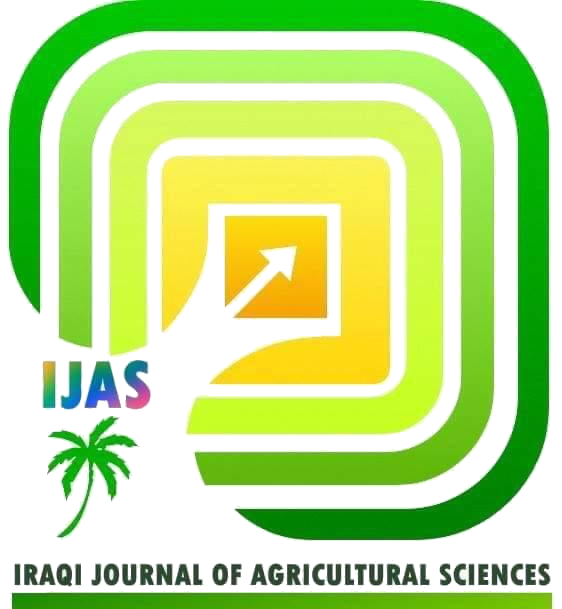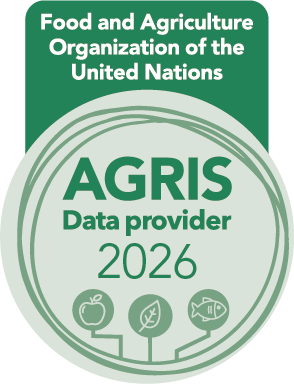RISK FACTORS AND REFERENCE VALUES OF ANTIBIOTIC RESIDUES IN IMPORTED RED MEAT AND THEIR IMPACTS ON GENOTOXICITY AND DNA DAMAGE IN HUMAN LYMPHOCYTES
DOI:
https://doi.org/10.36103/a5sj0x64Keywords:
antibiotic residues, referencevalues, genotoxicity, red meat, Iraq, food safetyAbstract
Antibiotic residues in food are accelerate the development of antibiotic resistance in bacteria, transfer of antibiotic-resistant bacteria to humans, cause allergies (penicillin), and cancers. This study was designed to investigate the risk factors of some antibiotic residue in imported red meat at Baghdad markets, their reference values, and their impact on genotoxicity and DNA damage in human cells.Atotalof144 meat samples were collected from January to July 2022.The results showed that the overall contamination percentage was35.4%. Buffalo meat showed the lowest contamination percentage 15% whereas the minced beef showed the highest (94.5%) (OR=402.33).Tetracycline residues detected in 42.8% of samples with significant risk (P=0.0001)(OR=33.37;95%CI=7.74-143.94).The mean of tetracycline was 83.80 ppb with lower and upper limits of 56.7, 110.9 ppb, respectively. Blood samples of 18 healthy males were used to isolate lymphocytes to detect the genotoxicity and DNA damage of antibiotic residues. Results showed significant effects of antibiotic residues on genotoxicity and human DNA damage. These results also showed that although the antibiotics residues concentrations are below the allowed maximum residues limit, this does not reduce the hazards of these residues on public health resulting from their accumulative increase in consumers' tissues.
References
1. Al-ghanimi, G. M. M., and A. M. Alrubeii. 2024. Effect of elastin hedrolyses on the chemical composition and some oxidation indicators in cold-stored ground beef. Iraqi Journal of Agricultural Sciences, 55(2):885-893. https://doi.org/10.36103/wfj0ra89
2. Abdullah E. N. 2024. Estimation of contamination with some metallic elements in canned processed meat products available in local markets, Iraqi Journal of Agricultural Sciences, 55(4):1502-1507. https://doi.org/10.36103/3xrbdw07
3. Al-Khshali, M.S., and N.Y. Karim. 2024. Evaluation of sensory characteristics of some atlantic salmon products imported to Iraq. Iraqi Journal of Agricultural Sciences, 55(2), 659-664. https://doi.org/10.36103/0n7wcs58
4. Abu-Zahra, N. I. S., A. A. Atia, M. M. Elseify, and Sh. Solima, 2024. Biological and histological changes and DNA damage in Oreochromis niloticus exposed to oxytetracycline: a potential amelioratory role of ascorbic acid.Aquaculture International 32:3889–3916 . DOI:10.1007/s10499-023-01356-5
5.Ad'hiah, A. H., K. W. Al-Samarraei, and R. M. Al-Ezzy, 2011. Assessingtheanti-mutagenic potentials of sage salvia officinal's L. leaf aqueous extract in cultured blood cells of acute lymphocytic leukaemia patients using the micronucleus formation assay. Journal of Biotechnology Research Center,5(2),25-30.
DOI:https://doi.org/10.24126/jobrc.2011.5.2.158
6. Al-ghanimi, G. M. M., and A. M. Alrubeii. 2020. Studying the effect of adding different concentrations of astaxanthin and allyl isothiocyanate and their synergistic action in lipid oxidation and some quality characteristics for minced veal meat at cold storage. Diyala Agricultural Sciences Journal, 12(Special Issue), 664–674. https://doi.org/10.52951/dasj.20121056
7. Ahmed S.A,D. H. A. Mohammed, S. G. Jassim ,A. F. Hashim and M. J. Laibi. 2017. Detection of antibiotic residues in food animal source and feed. Iraq J journal of Agricultural Research, 22, ( 3):133-139.
8. Al-Kindi. S., I. I. ALBalushi, A. Y. A. Elshaar, A. Al-Kharusi, R.Al-Maimani and A. A. Alka 2023. Determination of Tetracy clineresi duesinre dmeatavailablein Oman.Research Journal of Pharmacy and Technology .16(5):2182-6
doi: 10.52711/0974-360X.2023.00358
9-Al-Mashhadany. D. A. 2020. Monitoring of antibiotic residues among sheep meats at Erbil city and thermal processingffectontheirremnants. Iraqi Journal of Veterinary Sciences,.34, (2), 217-222.
DOI: 10.33899/ijvs.2019.125814.1161
9. Al-salmany, A. S. M., and A. M. S. AL-Rubeii. 2020. Effect of cinnamon and turmeric nanoparticles extract in quality characteristics of fresh ground beef during cold storage. Annals of Tropical Medicine and Public Health, 23(2): 200–213.
10. Al-Sudany, A. M. 2005. Inhibitory effects of black seed oil and honey on the genotoxicity oftamoxifen in mice. M.Sc .Thesis ,College of Science, Al-Nahrain University, Iraq
11. Arsène, M. M. J., A. K. L. Davares, P. I. Viktorovna, S.L. Andreevna, S. Sarra, I. Khelifi and D.M. Sergueïevna, 2022.The public health issue of antibiotic residues in food and feed: Causes, consequences, and potential solutions. Veterinary World, 15(3), 662. doi: https://doi.org/10.14202/vetworld.2022.662-671
12. Bacanl, M.G. 2024. The two faces of antibiotics: an overview of the effects of antibiotic residues in foodstuffs. Arch Toxicol 98, 1717–1725.
https://doi.org/10.1007/s00204-024-03760-z
13. Bafana, A., K. Krishnamurthi, S. Sivanesan and P.K. Naoghare, 2018. Mutagenicity and genotoxicity testing in environmental pollution control. Mutagenicity: Assays and Applications (pp. 113-132). Academic Press.
DOI: 10.1016/B978-0-12-809252-1.00006-7
14. Bedale, W. A., A.L. Milkowski, C.J. Czuprynski and M.P. Richards, 2023. Mechanistic Development of Cancers Associated with Processed Meat Products: A Review. Meat and Muscle Biology, 7(1): 15762, 1–63 (2023).
doi:10.22175/mmb.15762
15. Breijyeh Z., B. Jubeh and R. Karaman, 2020.Resistance of Gram-Negative Bacteria to Current Antibacterial Agents and Approaches to Resolve It. Molecules. 25:1340. doi: 10.3390/molecules25061340.
16. Bobate, S., S. Mahalle, N.A. Dafale, and A. Bajaj, 2023. Emergence of environmental antibiotic resistance: Mechanism, monitoring and management. Environmental Advances,13;100409. https://doi.org/10.1016/j.envadv.2023.100409.
17. Collins, A., P. Møller, G. Gajski, S. Vodenková, A. Abdulwahed, D. Anderson and A. Azqueta, 2023. Measuring DNA modifications with the comet assay: a compendium of protocols.NatureProtocols, 18(3), 929-989. doi:10.1038/s41596-022-00754-y. Epub 2023Jan27.
18. Cvetković, V. J., T. D. Miladinov and S. Stojanović, 2018. Genotoxicity and mutagenicity testing of biomaterials. Biomaterials in clinical practice: Advances in Clinical Research and Medical Devices, 501-527.Springer International Publishing.
DOI:10.1007/978-3-319-68025-5_18
19. Er, B., F. K. Onurdağ, B. Demirhan, S. O. Özgacar, A.B. Öktem and U. Abbasoğlu, 2013. Screening of quinolone antibiotic residues in chicken meat and beef sold in the markets of Ankara,Turkey. Poultry Science, 92(8), 2212-2215.
doi: 10.3382/ps.2013-03072.
20. Fahim, H. M. 2019. Evaluate antibiotic residues in beef and effect of cooking and freezingonit. Benha Veterinary Medical Journal,36(2),109-116.
DOI: 10.21608/bvmj.2019.13927.1029
21. Fenech M. 2000. The invitromicr-onucleustechnique. Mutat Res.20;455(1-2):81-95.
doi:10.1016/s0027-5107(00)00065-8. PMID: 11113469.
22. Fei, Z., S. Song, X. Yang, D. Jiang, J. Gao and D. Yang, 2022. Occurrence and risk assessment of fluoroquinolone residues in chicken and pork in China. Antibiotics, 11(10), 1292. https://doi.org/10.3390/antibiotics11101292
23. Galdíková, M., V. Schwarzbacherová, and M. Drážovská, 2020. Genotoxicity testingofbovine lymphocytes exposedto epoxiconazoleusing alkaline and neutral comet assay.Caryologia, 73(4), 99-109.
DOI:
https://doi.org/10.13128/caryologia-984
24. Geffré A, D Concordet, J.P Braun and C. Trumel, 2011. Reference Value Advisor: a new freeware set of macroinstructions to calculate reference intervals with Microsoft Excel. Vet Clin Pathol. Mar;40(1):107-12. doi: 10.1111/j.1939-165X.2011.00287.x. Epub 2011 Feb 7. PMID: 21366659.
25. Ghimpețeanu, O. M., E. N. Pogurschi, D. C. Popa, N. Dragomir, T. Drăgotoiu, O.D. Mihai and C.D. Petcu, 2022. Antibiotic use in livestock and residues in food—A public health threat: Areview. Foods, 11(10), 1430. https://doi.org/10.3390/foods11101430
26. Hou, L., Y. Fu, C. Zhao, L. Fan, H. Hu and S. Yin, 2024. The research progress on the impact of antibiotics on the male reproductive system. Environment International, 108670. https://doi.org/10.1016/j.envint.2024.108670
27. Jabbar, A. and S. Ur-Rehman. 2013. Microbiological evaluation of antibiotic residues in meat, milk and eggs. Journal of Microbiology, Biotechnology and food Sciences, 2(5), 2349-2354.
28. Jain, A. K., D. Singh, K. Dubey, R. Maurya and A. K. Pandey, 2018. Chapter Four: Chromosomal aberrations. Mutagenicity: Assays and Applications (pp. 69-92). Academic Press. https://doi.org/10.1016/B978-0-12-809252-1.00004-3
29. Jones, G. M., and E. H. Seymour, 1988. Cow side antibiotic residue testing. Journal of dairy science, 71(6), 1691-1699. https://doi.org/10.3168/jds.S0022-0302(88)79734-9
30.Jutzi, S. 2004. Good practices for the meat industry (No. 2). Food & Agriculture Organization of the United Nations. Rome.. https://openknowledge.fao.org/handle/20.500.14283/y5454e
31. Kyuchukova, R. 2020. Antibiotic residues and human health hazard-review. Bulgarian Journal of Agricultural Science, 26 (No 3) 2020, 664–668. https://www.researchgate.net/publication/342766423
32. Ma, F., S Xu, Z. Tang and Z,Li,L,Zhang. 2021. Useof antimicrobials in food animals and impact of transmission of antimicrobial resistance on humans. Biosafety and Health, 3(1): 32-38. https://doi.org/10.1016/j.bsheal.2020.09.004
33. Maddim S., T. Goud and P. Srivastava, 2017. Cytochrome p450 Enzymes, Drug Transporter sand theirrolein Pharmacokinetic Drug- Druginteractions of Xenobiotics: Acomprehensive review, J. Med Chem Res 3(1):1-11.
DOI: http://dx.doi.org/10.17352/ojc.000006
34. Med Calc Statistical Software version 16.4.3 (MedCalc Software bvba, Ostend, Belgium; https://www.medcalc.org; 2016)"
35. Monger, X. C., A. A. Gilbert, L. Saucierand and A. T. Vincent, 2021. Antibioticresistance: From pig to meat.Antibiotics, 10(10), 1209. https://doi.org/10.3390/antibiotics10101209
36- Majd A. A, A. M. S. Alrubeii, and L. T. Al–Hadedee. 2025. Using of electrospun chromium oxide nanpfiber to increase the shelf life of frozen beef burger. Iraqi Journal of Agricultural Sciences, 56(Special), 102-110. https://doi.org/10.36103/2x991f27
37.Murray, C. F., Fick, L. J., Pajor, E. A., Barkema, H. W., Jelinski, M. D., and Windeyer, M. C. 2016. Calfmanagementpracticesandassociationswithherd-levelmorbidityandmortality on beef cow-calf operations. Animal, 10(3), 468-477. DOI: 10.1017/S1751731115002062
38. Najim N. H., K. F. Khazal and J.H. Ali, 1988.Antibiotics residues in milk of Baghdad aera. The Iraqi Journal of Veterinary Medicine, 12(1),32-38. https://doi.org/10.30539/ijvm.v12i1.1682
39. Najim. N. H and S. A. Al-Kurashi. 2017. Detection ofantibioticresiduesinlocallyraw milk by using high performance liquid chromatography at different seasons and the effect of heat treatment on their concentration. The Iraqi Journal of Veterinary Medicine, 41(2):131-136. DOI: https://doi.org/10.30539/iraqijvm.v41i2.62
40. Ngangom,. B. L, Tamunjoh, S. S. A and Boyom, F. F. 2019. Antibioticresiduesinfoodanimals: Public health concern. Acta Ecol Sin 39(5):411–415. https://doi.org/10.1016/j.chnaes.2018.10.004
41. Orozco-Hernandez, J.M., L.M. Olivan, G. Heredia-García, M. Luja-Mondragon, H.Islas- Flores,H., N. SanJuan-Reyes and M. Galar-Martínez,et al. 2019 .Genotoxic and cytotoxic alterations induced by environmentally-relevant concentrations of amoxicillin in blood cells of Cyprinus carpio. Chemosphere 236:124323. https://doi.org/10.1016/j.chemosphere.2019.07.054
42. Patel, S.J., M. Wellington, and R.M. ShahandM.J. Ferreira, 2020.Antibiotic stewardshipin food-producing animals: challenges, progress, and opportunities. Clinical Therapeutics, 42(9), 1649-1658.DOI: 10.1016/j.clinthera.2020.07.004
43. Rahman M. S., M. M. Hassan, and S. Chowdhury, 2021.. Determination of antibiotic residues in milk and assessment of human health risk in Bangladesh. Heliyon. 8;7(8):e07739.
doi: 10.1016/j.heliyon.2021.e07739. PMID: 34430734; PMCID: PMC8365374.
44. Ramatla, T., L., Ngoma and M. Adetunji, and M. Mwanza, 2017. Evaluation of antibiotic residues in raw meat using different analytical methods. Antibiotics, 6(4), 34. https://doi.org/10.3390/antibiotics6040034
45. Ramadhani, D., S. Purnami, D. Tetriana, I. Sugoro, V.A. Suvifan, N. Rahadjeng and M.Syaifudin, 2023. Chromosome aberrations, micronucleus frequency, and catalase concentration in a population chronically exposed to high levels of radon. International Journal of Radiation Biology, 99(8), 1188-1203.
DOI: 10.1080/09553002.2022.2110314
46. SAS. 2010. SAS/STAT Users Guide for Personal Computer. Release 9.13.SAS Institute, Inc., Cary, N.C., USA.
47.Sarkar, S., M. J. Souza, T. Martin-Jimenez, M. A. Abouelkhair, S. A. Kania and C. C. Okafor, 2023. Tetracycline, Sulfonamide, and Erythromycin Residuesin Beef, Eggs, and Honey Sold as“Antibiotic-Free” Products in East Tennessee(USA) Farmers’Markets. Vet. Sci. 10,243. https://doi.org/10.3390/vetsci10040243
48. Seo, J., F. Kloprogge, A. M. Smith, K. Karuand and K., L. Ciric, 2024. Antibiotic Residuesin UK Foods: Exploringthe Exposure Pathways and Associated Health Risks. Toxics,12(3),
174.https://doi.org/10.3390/toxics12030174
49. Shubber E. K. 1987. Sister-chromatid exchanges in lymphocytes from patients with Schistosoma hematobium. Mutat Res. 180(1):93-9. doi: 10.1016/0027-5107(87)90071-6. PMID: 3114626.
50. Silva-Guedes, J., A. Martinez-Laorden and E. Gonzalez-Fandos, 2022 .Effect of the presence of antibiotic residues on the microbiological quality and antimicrobial resistance in fresh goat meat.Foods,11(19):3030; https://doi.org/10.3390/foods11193030
51. Treiber, F. M. and H. Beranek-Knauer, 2021.Antimicrobial residuesin food fromanimal origin—A review of the literature focusing on products collected in stores and markets worldwide. Antibiotics, 10(5), 534. https://doi.org/10.3390/antibiotics10050534
52. Wali, M. K., and A.H. Deri, 2022.Effect of thermal processing on antibacterial drug residue of tetracycline and sulfonamide in fresh beef meat and Iraqi processed meat. Intl J Health Sci. 6(S2)https://doi.org/10.53730/ijhs.v6nS2.6701
53. Zhang , Y., J. Lu, Y. Yan, J. Liuand and M. Wang, 2021. Antibioticresiduesincattle and sheep meat and human exposure assessment in southern Xinjiang, China. Food Sci Nutr, 9(11):6152-6161.
Downloads
Published
Issue
Section
License
Copyright (c) 2025 IRAQI JOURNAL OF AGRICULTURAL SCIENCES

This work is licensed under a Creative Commons Attribution-NonCommercial-NoDerivatives 4.0 International License.

2.jpg)


